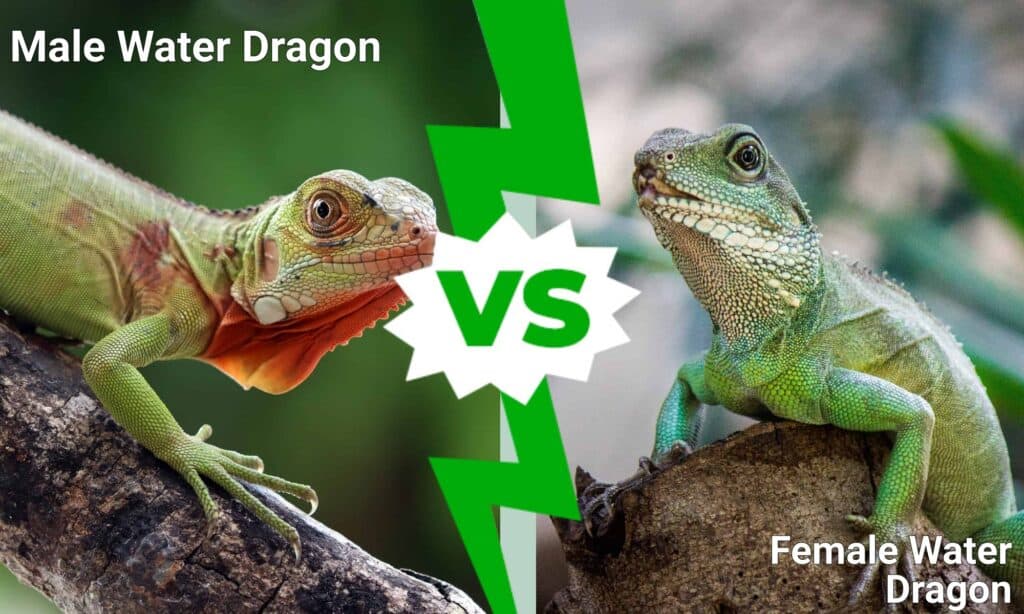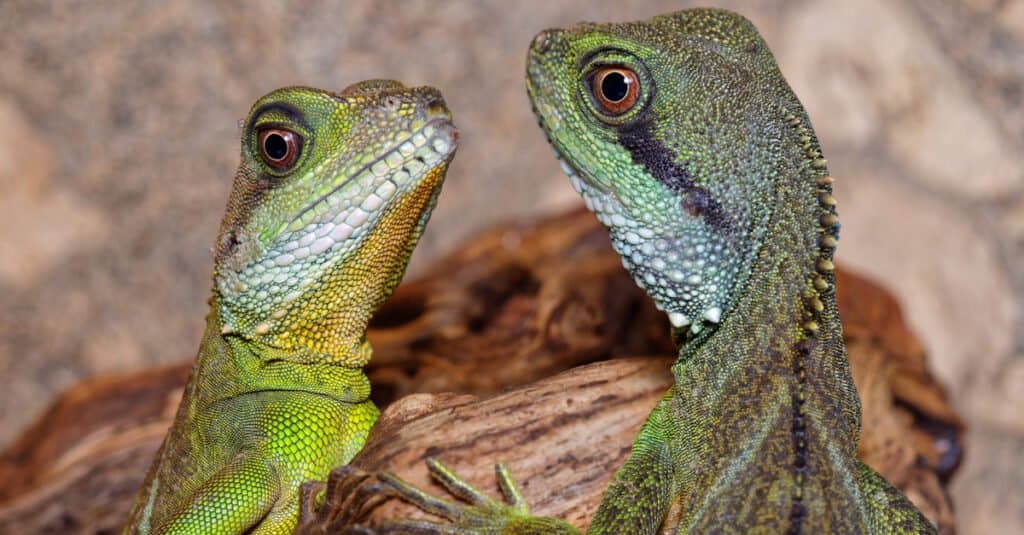As humans, we generally find it pretty easy to tell the difference between males and females in our own species. But what about other species? Even though they can probably tell each other apart pretty easily, sometimes nothing makes their sex obvious to us.
However, sometimes it’s about learning the subtle differences between the sexes within different species. Take the Asian water dragon, for example. A truly fascinating animal, there are many visible differences between the sexes that we may not know unless we take the time to learn about them.
Right now, we are going to go through the various male vs. female water dragon differences. Once you’re done reading this article, you’ll be able to distinguish between adult male and female Asian water dragons fairly easily!
Comparing Male vs. Female Water Dragon

| Male Water Dragon | Female Water Dragon | |
|---|---|---|
| Size | Can be more than 35 inches long. | Typically do not exceed 23 inches in length. |
| Coloring | Green color, development of bright orange or yellow markings just under their throats, as well as bright pink around the bottom edge of the mouth. | Deep green color, with no other significant markings. |
| Anatomical Variations | More prominent ridges on the necks, tails, and upper bodies. Crest will stick out more, spikes will lengthen, and a ridge will develop under the spikes. Head will become bigger and develop more of a triangular shape, cheeks and jowls will become more pronounced, femoral pores will become larger and start to emanate a substance that allows them to claim territory. | Very subtle changes at maturity, with abdominal region becoming more round or pear-shaped. |
| Behavior | Aggressive and territorial behavior, constant nodding that is likely an attempt to attract females. | Will lay eggs, even without a mate. |
Male vs. Female Water Dragon: Key Differences
The key difference between male and female water dragons are size, coloring, anatomical variations, and behavior. One thing that is important to note is that all Asian water dragons have the appearance of a female until they are about 18 months old. Both male and female juvenile dragons have somewhat triangular heads, little crests on the backs of their necks, and small spikes on their crests and down their tails.
What you should do is wait until your dragon is a total length of 14 to 18 inches, snout to tail. Once the dragon has reached this size, if it is male, masculine characteristics would have started to appear. If the dragon still looks female at this point, she is female.
Males grow to be bigger, more colorful and develop more salient behaviors that show aggression and attempts to attract females. They also undergo more noticeable changes to their bodies upon maturity than females do.
Let’s look at these differences in a little bit more detail now.
Male vs. Female Water Dragon: Size

All juvenile water dragons look like female dragons; male dragons only develop masculine characteristics when they reach maturity.
©Valt Ahyppo/Shutterstock.com
Asian water dragons can grow to be about 3 feet or 1 meter, long. The tail makes up about 70% of the body’s length. Females tend to be smaller than males.
Typically, male water dragons are able to grow to be more than 35 inches long, while females can usually only get up to about 23 inches.
Male vs. Female Water Dragon: Coloring
Looking at the coloring of a mature water dragon can also assist you in identifying the gender. These dragons are typically a deep green color. However, the males are a little bit more colorful, as a general rule.
Just below their throats, you will see colorful orange or yellow markings on male water dragons. You will also see a bright pink color around the bottom edge of the male’s mouth. Neither of these bright colors will be present on female dragons.
Male vs. Female Water Dragon: Anatomical Variations
Once the male water dragon reaches adulthood, its body will start to change. You’ll start to see more prominent ridges on their necks, tails, and upper bodies. The crest will jut out more, and the spikes will become longer. The male dragon will also have a ridge under the spikes that point upwards, which females do not have.
Their heads also become bigger, with a triangular shape. Their cheeks and jowls are more pronounced as well. The femoral pores on the insides of the backs of the legs of these dragons are also bigger in males. In fact, these pores emanate a sticky matter that makes it possible for the males to claim territory.
Female dragons undergo more subtle changes; their shape changes slightly, becoming more round or pear-shaped in the abdominal region. Also, her tail stays somewhat rounded, compared to the triangular tail of the male.
Male vs. Female Water Dragon: Behavior

Aggressive and constant nodding likely indicates that a water dragon is male; female dragons will lay eggs, even without a mate.
©iStock.com/Nigel Jarvis
Behavior can also be useful in figuring out whether one of these water dragons is male or female. A mature male dragon will sometimes act aggressively against others who he perceives to be invading his territory. Additionally, if one of these lizards is constantly nodding, it is most likely a male trying to attract a female.
Additionally, female water dragons will lay eggs, even if they don’t have a mate. The unfertilized eggs just won’t hatch.
The photo featured at the top of this post is © iStock.com/Nigel Jarvis
Thank you for reading! Have some feedback for us? Contact the AZ Animals editorial team.






